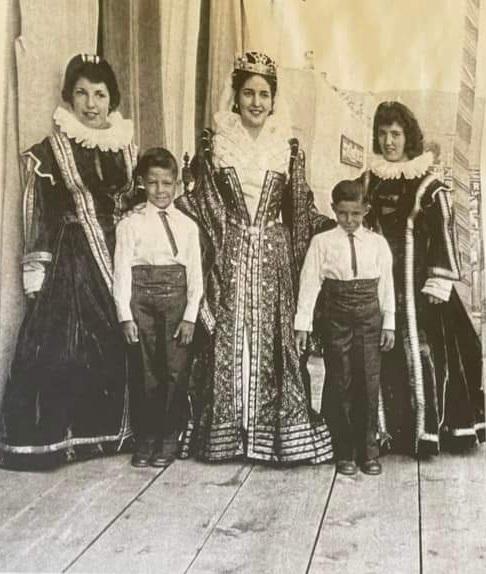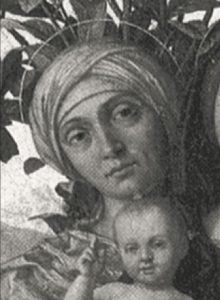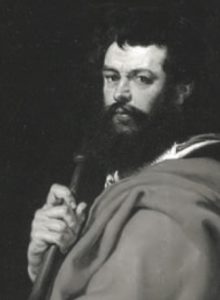
History
Fiestas de Taos is a community celebration honoring the two patron saints of Taos, Santa Ana and Santiago. See below, stories from Taos historian Larry Tores. The Taos News has allowed these reprints of articles run in previous Fiestas Visitor’s Guides.
Photo courtesy Sonya F. Romero: 1957 Fiesta Court Reina Martha Martinez, Attendants Kathy Vigil, Erlinda Martinez, Pageboys Larry and Toby Santistevan.
SAINT ANNE: A Model of Virtue
Once again this month, as since time immemorial, the good people of Taos will be celebrating the Feast of St. Anne and St. James. The annual event, popularly referred to as “The Taos Fiestas,” invites the local population to put aside their labor for two days and bask in the leisure of the holy days.
St. Anne, who was chosen from the beginning of time to be the mother of The Virgin Mary and therefore the grandmother of the Messiah, was born to wealthy parents. This is known to us through the writings left behind by mystics such as Venerable Catherine Emmerich, St. Bridget of Sweden, Venerable Maria de Agreda of Spain and St. Elizabeth of Schoenau. According to St. Bridget, who was in constant spiritual communication with The Virgin Mary, she was told: “It is a truth that I was conceived without Original Sin and not in sin. A golden hour was my conception. My Son joined my father (Joachim) and my mother (Anne) in a marriage of such chastity that a purer union has never been seen. Sensuality was extinguished in them. Thus my flesh was formed through divined charity.”

St. Bridget has revealed that among the Hebrew nation chosen by God to keep his law there were some who fastidiously observed greater order. Anne’s family would give a third of their yearly income to the temple, a third to charity and live off the last third. Even then, their flocks and holdings continued to multiply at their beautiful country estate in Sephoris, near Nazareth.
Just before Anne’s mother died, she told her of a revelation which said that Anne was a special vessel and that she should pray for a worthy husband. At the same time, there lived in another part of Nazareth a pious middle-aged bachelor who was seeking divine help in choosing a wife. The Angel Gabriel, who alone of all the angels knew her destiny, appeared to Anne and said: “The Lord give thee His blessing, servant of God! Continue to pray for the coming of the Redeemer and rejoice in the Lord. It is His will that thou accept Joachim as thy husband.”
Gabriel then went to Joachim and said, “Blessed be thou by the Lord, Joachim! Persevere in the practice of justice and perfection. The Lord wants thee to take Anne as thy wife. Take care of her and esteem her, for she is dear to Him, and give thanks to God.” The next day Joachim went to Anne’s father to ask permission to marry her. Anne was 24 at the time and Joachim was 42.
Twenty years went by and although they were a venerable couple, they remained childless. In those days to be without child was thought to be a curse since the couple was not contributing toward the birth of the promised Messiah. When Joachim went to offer sacrifice at the temple, he was rebuked by the high priest who said: “Why do you come here, Joachim? Your offerings are not acceptable to the Lord!” Face burning in shame, Joachim withdrew to the slopes of Mount Hermon where the family flocks were kept.
Back at home Anne wept in double misery; not only was she still childless at the age of 44, but also the gossip around town was that her husband had abandoned her. She lay prostate in her room praying and weeping when Gabriel once again came to her at God’s bidding.
He declared: “Anne, servant of God. The Lord has heard thy petitions. If He delays their fulfillment, it is in order to prepare thee and to give thee much more than thou askest. The Most High has resolved to give thee and Joachim holy and wonderful fruit, for those who pray to Him in humble confidence are most agreeable to Him. Now He sends me to give thee joyful news: He chooses thee to be the mother of her who is to give birth to the Redeemer of mankind! Thou shalt bring forth a daughter and she shall be called Mary. She shall be blessed among women and filled with the Holy Ghost. I have announced to Joachim that he shall have a holy daughter, but he does not know that she is to be the Mother of the Messiah. Therefore guard this secret. And now go to the temple to give thanks to the Lord, and thou shalt meet Joachim at the Golden Gate [of Jerusalem].”
That night Anne dreamed that an angel had written the name “Mary” in golden letters upon her bedroom wall. She pondered the mystery until the coming of dawn had erased the letters. The Angel Gabriel was busy that night visiting Joachim also. He revealed to him only that he was to have a daughter and that she would be consecrated to the service of the temple. He bid Joachim to go meet Anne at the Golden Gate.
Anne arose early the next morning and walked radiantly to the temple. She offered a solemn sacrifice of thanks. She then walked to the Golden Gate accompanied by some pious women, among whom was Anna the Prophetess. Anna was destined to instruct Mary at the temple until she came of age.
In another part of the temple Joachim was also preparing to offer sacrifice. By the grace of God his gift was accepted by the temple priests who were moved to do so by an angel. The priests then led Joachim to The Holy Place, where he fell on the floor in ecstasy. When he recovered, he led the way to the Golden Gate where Anne was waiting for him. They embraced in tender emotion and revealed to each other the message of the angel. Suddenly the heavens opened and The Most Holy Trinity looked down upon them with love and joy.
Later, Joachim and Anne left Jerusalem and returned to Nazareth, where they gave a big feast for the poor and distributed alms abundantly. Anne sat quietly at home and waited for the day when she would give birth to the girl who would be known as The Immaculate Conception.
The second day of The Taos Fiestas is always dedicated to St. Anne. On this day women were wont to ride in horse-drawn carriages. Mothers and older sisters hold tightly to the hands of the children and everybody marvels at the mystery of St. Anne, who is the perfect example of motherhood.
SANTIAGO: From Fisherman to Warrior

Santiago de Compostela is a name that falls rather anachronistically on the modern ear. Santiago is, after all, merely a contraction of Saint Yago, the Spanish words for St. James. And as to the word Compostela itself, many linguists have tried to equate it with Campus Estellae, or “Field of Stars,” from the splendor that shone up from the grave of St. James when it was discovered. It is more likely that the word Compostela came from the Latin word compostum meaning cemetery and, oddly enough, forerunner of the modern English word “compost” for decaying matter. Spanish people in Northern New Mexico call their own cemeteries camposantos — holy fields. Whatever the mystery in the name Santiago de Compostela, it is still a term that means much to the people of Taos at this time of year.
The original Spanish colonists established their first church of San Jerónimo at Taos Pueblo. Padre MartÌnez then changed the seat of ecclesiastical power to Nuestra SeÒora de Guadalupe in Taos proper. But the festival that honors Santiago and Santa Anna seems to transcend both of these historical facts. The Taos Fiestas honor the two saints annually. The first day is dedicated to Santiago, who is the patron saint of Spain. On that day, men used to ride on horseback through the plaza in their finest livery, “encatrinados” as they were called in their fancy attire.
One wonders just how the son of simple fisher-folk might feel knowing that he was going to inspire the religious unification of Europe throughout the Middle Ages and, later, to have a festival named after him in a land yet to be discovered.
James and his brother, John, were mending their nets one day on the shores of Lake Genesaret. They were the sons of lowly Zebedee. They were called by Jesus of Nazareth to be fishers of men. As Jesus got to know their personalities better with the passing of time, he gave them an additional name. That name was “Boanerges,” which means “sons of thunder” in Greek. The gospels speak of how James raised the dead daughter of Jairus to life in the name of Jesus. The Acts of the Apostles also says that he was the first of the apostles to undergo a martyr’s death for his faith. The story is that he was executed by King Herodes Agrippa I circa 44 A.D.
Popular tradition holds that James had preached in northwestern Spain when the area was still known as Galicia. It was to this area that the body of the Apostle of Spain was returned by two of the nine converts he had made in the area, Theodorus and Athanasius.
The faithful followers of St. James asked permission to entomb the body from Queen Lupa, known as the “She Wolf” (La Loba). This may have derived from the early writings of the founding of Rome in which Romulus and Remus were nursed by a she-wolf and caused the country to prosper. Whatever the case, Queen Lupa eventually converted after she had made the lives of the disciples miserable. St. James was buried in her palace and later, the Cathedral of Compostela was built on the same foundation.
In the year 711 Moorish invaders crossed from North Africa to Spain and dominated the country until 1492. A hero was needed to inspire people to action against the enemies of the faith. A rumor was spread that during the Battle of Clavijo of 834, when Ramiro I of Leon defeated Abdurrahman II, a vision had been seen in the sky above the battle. An armed horseman on a white charger was seen trampling his enemies. Thus, a humble fisherman became a fearsome warrior. The cry of “°Santiago Matamoros! (St. James Slayer of Moors!) was to echo in Spain for centuries.
According to the Codex Calixtinus a chapter in the Liber Sancti Jacobi, the first person known to make a pilgrimage to the tomb was French Bishop Gottskalk of Le Puy. By the 1100s though, a virtual sea of pilgrims adorned with scallop shells on their cloaks, were traipsing down from as far as Sweden. St. Bridget herself is known to have made the pilgrimage, as did St. Francis of Asis.
The exact spot of the tomb of the martyr was lost for over 800 years. A hermit named Pelagius had a vision of the site of the burial place. The site uncovered was aglow with light.
The bishop of Iria Flavia declared the bones to be “the authentic relics of St. James.” Again, the tomb was lost for a thousand years and rediscovered in the late 1800s.
It is important to recall the story of Santiago on occasion for much was sacrificed that we might have some joyful days of rest in the shade.
